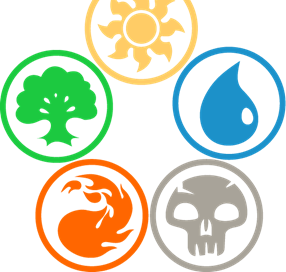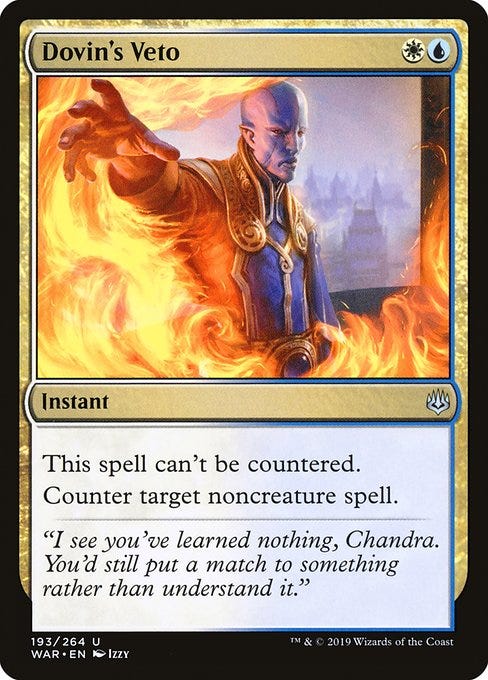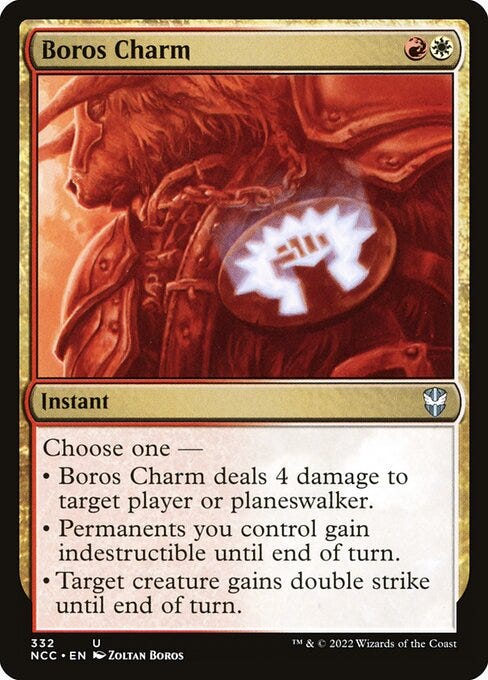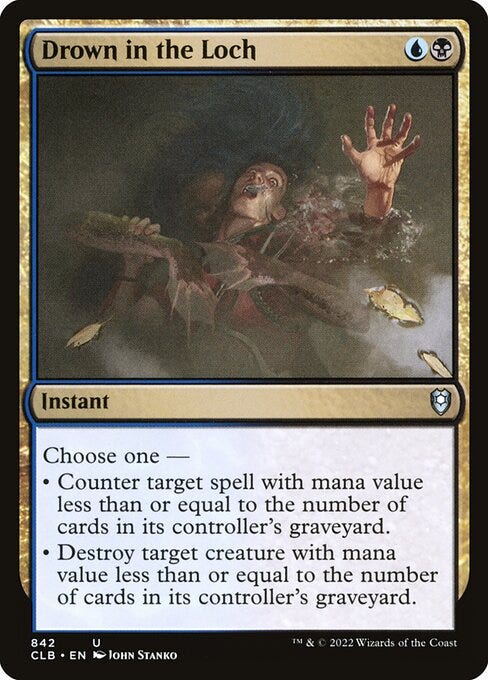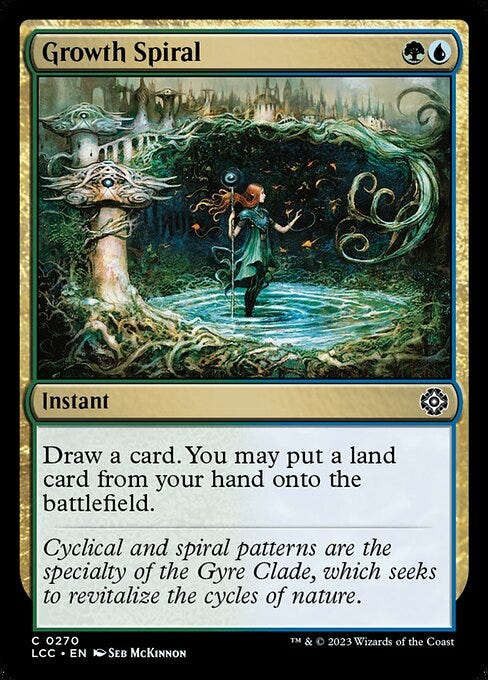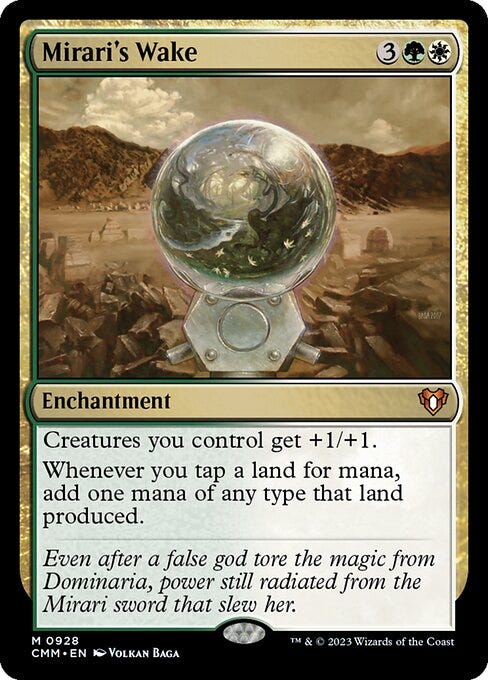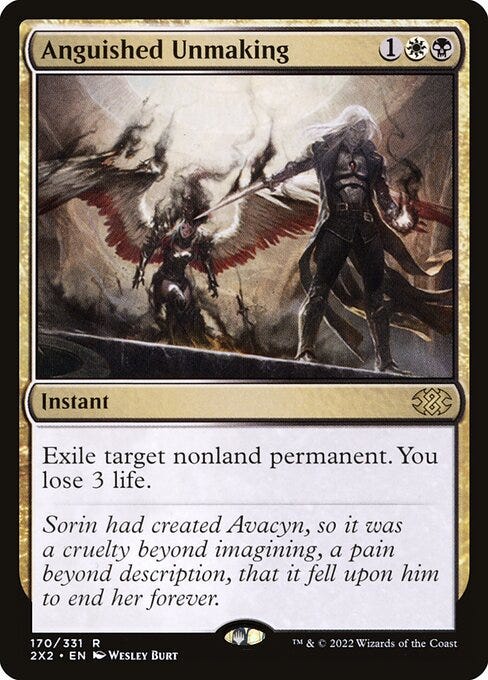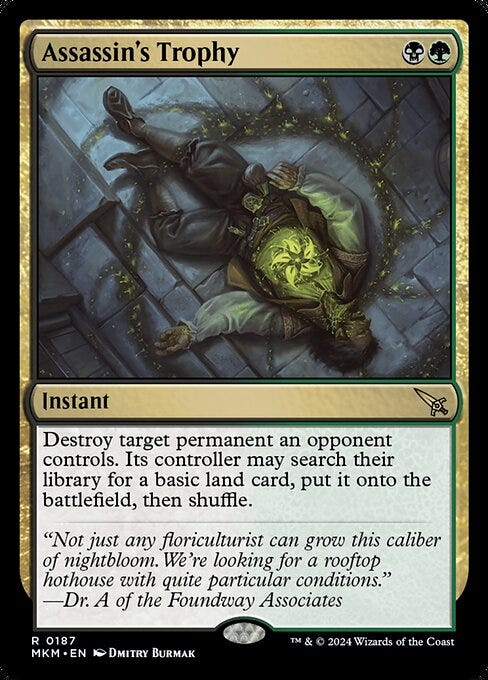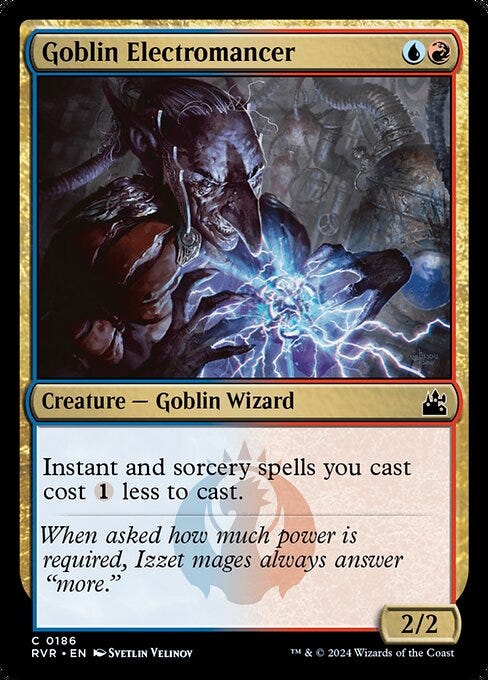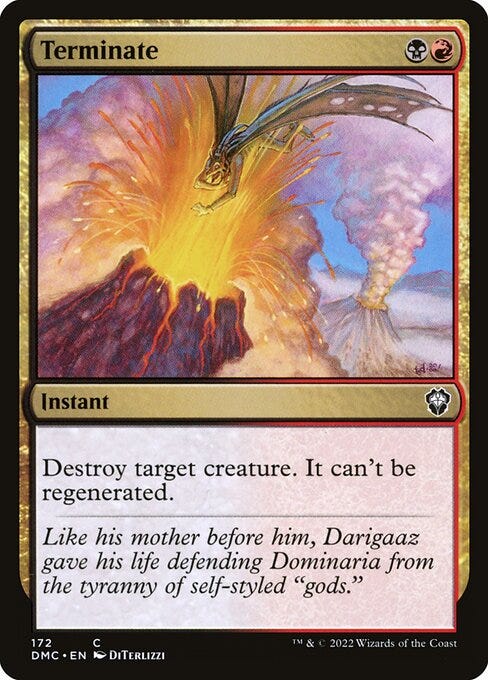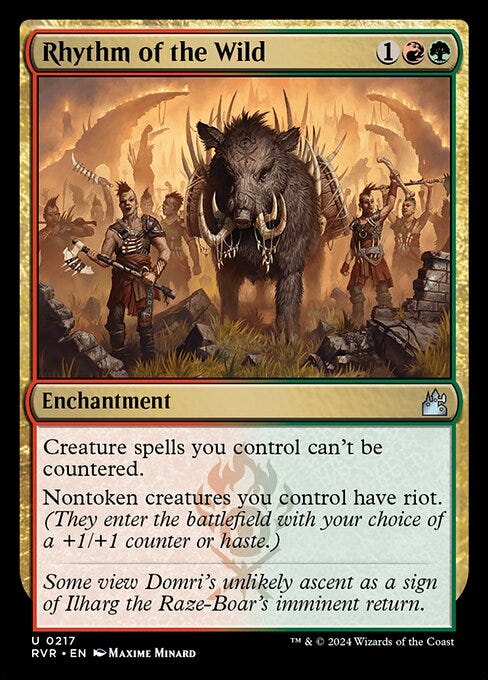Thea and I are currently addicted to Magic: the Gathering. Despite its reputation as “cardboard crack cocaine”, we’ve managed to not go entirely broke playing the game. Our preferred in-person game mode is kitchen-table magic, with little concern for blocks or sets. Neither one of us are inclined to go play competitively, nor do we care much about the multiplayer Commander format. (People aren’t really our thing. Individually they’re great, but taken as a whole…) As such, we pretty much throw cards together or use pre-cons that we got on the cheap. Luckily, one of my co-workers was cleaning out and granted us a bounty of assorted cards that we’ll sort through and build decks with one day.
The majority of our day-to-day play is on MTG: Arena, the free-to-play online version of Magic. I started playing MTG:A a little bit before Thea, and I was able to convert her to the dark side. (Cute avatars and sleeves were very helpful in that regard.) Through our time, we’ve developed a few opinions about the various slices of the color pie in Magic that we’d like to share with you this week. (Thea: Mainly, everything that has blue in it sucks. Red for LIFE!) We’re going to assume a basic familiarity with the game and how it works, but if you have specific questions, let me know in the comments.
We’ll be ranking the ten dual color pairings in Magic, using their Ravnica guild names for short. (We’ll also do a relatively shallow dive into the Ravnica lore, since it’s the primary story setting right now. Spoilers ahead!) These rankings take into account how much fun they are to play, and how frustrating they are to play against. Thanks to the miracle of netdecking and other less-than-legitimate platforms, we’ve been able to build these combinations pretty thoroughly so we’ve got a fairly extensive history with each. For each pairing, we’ll talk about what the guilds are known for, the storyline behind the guild, which cards are most notable in their preferred playstyle, and what strategies play well against them. I will be doing most of the writing, but don’t be surprised if Thea chimes in here and there (like above).
Let’s get started with the consensus worst combo with number ten…
10. Azorius (Blue / White)
Prime strategies: Control, Evasion (Flying), Card Draw
Parun (Founder): the sphinx Azor, the Lawbringer
Guildmaster (Current Leader): Lavinia of the Tenth (acting)
Champion (Signature Character): Lavinia
Prototypical Card: Dovin’s Veto
As someone who’s most successful ranked deck on Arena is Azorius Soldiers, I can say that blue/white is usually boring as all get out. Games tend to grind out, thanks to the white weenie strategy of throwing out a bunch of cheap creatures and using the blue counterspells to keep opponents from doing anything interesting. If you’re playing against an Azorius deck, expect to die a death of a thousand cuts in between long interminable turns. In storyline, the blue/white guild is composed of the cops and judges, meaning that they definitely fall under the strictures of ACAB. For commander, legends like Shorikai, Genesis Engine, Grand Arbiter Augustin IV, and D&D import Elminster have a tendency to slow tempo and generally make the game more difficult to play. 0/10, would not recommend.
9. Boros (Red / White)
Prime strategies: Equipment, Weenies, Burn
Parun: the archangel Razia
Guildmaster: the angel Aurelia, the Warleader
Champion: Tajic, Blade of the Legion
Prototypical Card: Boros Charm
This is a case where Thea and I differ in our interpretation of what’s good about Magic. I have a pretty good feeling about Boros, since I like the idea of white weenies turbocharged by either equipment or enchantment. On the other hand, Thea despises the entire concept of equipment and disdains enchantments wherever possible (Thea: it’s true. Too many things, not enough swings.). For storyline purposes, the Boros Legion is the standing angelic army of Ravnica, brutally enforcing the laws of the land set up by the Azorius Senate. Boros cards are either stupidly simple (like Iroas, God of Victory) or mind-bogglingly complex like Duke Ulder Ravengard and Queen Kayla bin-Kroog. At least they move faster than blue/white. I have a feeling that Boros will rise up the rankings once Commander Mustard is in wide release, because that card is ridiculous. As a soldier typal player, it’s definitely on my wishlist.
8. Dimir (Blue / Black)
Prime strategies: Control, Graveyard, Mill
Parun: the vampire Szadek, Lord of Secrets
Guildmaster: the shapeshifter Lazav, the Multifarious
Champion: the vampire Etrata, the Silencer
Prototypical Card: Drown in the Loch
House Dimir represents all the shadowy, underhanded, manipulative stuff that needs doing in Ravnica. As such, the blue/black combo signifies every bit of trickery, deceit, and sneakiness that the game has to offer. Everything from direct murder spells like Feed the Swarm and Infernal Grasp to “actually, no” spells like the classic Counterspell and Negate help make Dimir infuriating to play against. (Especially if you’re Thea.) In storyline, Lazav’s crew originally were completely unknown mysterious villains until their existence was revealed by the Decamillenial (and Szadek’s subsequent arrest for trying to kill Mat’Selesnya), after which they were thrust into the public eye. Oh, and they have zombies. (Like Wilhelt, the Rotcleaver.) And ninjas. (Like Yuriko, the Tiger’s Shadow.) And straight up horrors like Captain N’gathrod and Umbris, Fear Manifest.
7. Simic (Blue / Green)
Prime strategies: Card Draw, +1/+1 Counters, Ramp
Parun: an otherwise anonymous Vedalken biomancer named Simic
Guildmaster: the elf ooze wizard (yeah, I know) Vannifar, Evolved Enigma
Champion: the merfolk wizard Zegana, Utopian Speaker (until Murders at Karlov Manor…)
Prototypical Card: Growth Spiral
Did you ever read The Island of Dr. Moreau? Yeah, that. The Simic Combine specializes in mutating and hybridizing creatures to make the world a weirder place. Officially, they want to keep the balance of life and evolution in the face of the more industrial-minded guilds (looking at you, Izzet…) but they take it to the extreme. Mechanically, the blue/green combo wants to grow their side of the board, whether with extra land drops, more +1/+1 counters, or strange spells like Ripples of Potential, Rapid Hybridization, or Bygone Marvels. Their most popular commanders are equally baffling, such as Ivy, Gleeful Spellthief, Lonis, Cryptozoologist, and even the adorable (and adorably broken) Xolatoyac, the Smiling Flood. That’s right, an axolotl that untaps everything with counters.
6. Selesnya (Green / White)
Prime strategies: Tokens, +1/+1 counters, Lifegain, Enchantments
Parun: the dryad elemental Mat’Selesnya (who is unrepresented in card form)
Guildmaster: the dryad Trostani (until Murders at Karlov Manor…)
Champions: the elves Emmara Tandris and Tolsimir Wolfblood
Prototypical Card: Mirari’s Wake
If you’ve read Lord of the Rings, imagine what would happen if Treebeard (Fangorn if you’re nasty) and the Ents decided to whomp on every other fantasy creature under the sun, and you get the Selesnya Conclave. In storyline the conclave has all the appearance of hippy-dippy treehuggers (if not actual trees), but the truth is more dastardly: the dryad leadership is directly behind the conspiracy of Murders at Karlov Manor. The triple-headed guild leader Trostani arranged for the demise of Zegana and Teysa Karlov, while the vlashino Izzet inventor Kylox and her own guildmate Tolsimir Wolfblood were collateral damage. Mechanically, the green/white combo is tailor made for go big and go wide strategies. Cards like Rhys the Redeemed and Hamza, Guardian of Arashin make tokens, make them big, then make bigger tokens. If you pair them with insane cards like Ghalta and Mavren, you get trampling lifelinked vampires to go with it.
5. Orzhov (Black / White)
Prime strategies: Aristocrats, Typal, Lifegain
Parun: a collective council of ghosts called Obzedat
Guildmaster: the intangible slayer Kaya Cassir until usurped by…
Champion: the newly dead ghost mage Teysa Karlov
Prototypical Card: Anguished Unmaking
Urban fantasy is kind of my jam (shout out to Richard Kadrey and Stephen Blackmoore), so a cadre of undead mobsters ruling from the shadows is almost de rigueur for me. The fact that the Orzhov Syndicate also strongly resembles the Hecata from World of Darkness TTRPGs is a bonus. (Should I do a V:TM clan ranking next?) Their religious trappings serve as a wonderful opportunity for the architects of the story to satirize monolithic organized religions as well. Mechanically, the black/white combo utilizes targeted removal like Damn and Swords to Plowshares in conjunction with sacrificing their own resources with cards like Bartolomé del Presidio and Cruel Celebrant to gain advantage. The signature creature types are vampires (the universe is telling me to go full WOD), zombies, and angels, all synergistic with bleeding an opponent dry.
4. Golgari (Black / Green)
Prime strategies: Graveyard, Graveyard, Graveyard
Parun: the elf lich Svogthos, the Restless Tomb
Guildmaster: the Phyrexian (space zombie) Gorgon assassin Vraska, the Unseen
Champion: the dark spider/elf Izoni, Thousand-Eyed
Prototypical Card: Assassin’s Trophy
Thea has a mental block on sacrificing creatures or deliberately losing life to power a deck strategy, so she disdains pretty much all Golgari mechanics. On the other hand, I’m far more comfortable digging around in a graveyard to unleash its eldritch powers. The black/green combination is all about the nasty, gritty damage that comes with controlling vermin like rats, insects, and even fungus to eliminate your opponents. Have you ever seen the nature documentaries about cordyceps fungus mind-controlling other creatures via parasitic infection? That’s what the Golgari Swarm is all about. (No, The Last of Us is not a nature documentary.) My favorite Golgari commanders are easily Skullbriar and Lathril, both excellent examples of doing damage and then reaping the rewards. Cards like Moldervine Reclamation and Poison-Tip Archer help achieve those aims.
3. Izzet (Red / Blue)
Prime strategies: Spellslinger, Artifacts, Burn
Parun: the dragon avatar Niv-Mizzet, the Firemind
Guildmaster: the storm mage Ral Zarek, Caller of Storms
Champions: the husband and wife mages Tibor and Lumia
Prototypical Card: Goblin Electromancer
For Christmas this year, I asked someone to make a pair of pauper decks for Thea and myself. Hers was a Selesnya dinosaur deck, while mine was an Izzet spellslinger deck featuring the above Goblin Electromancer. The blue/red combination is all about instants and sorceries to manipulate the board state as sneakily and underhandedly as possible, meaning that Thea really hates playing against it. (As much as she loves red, she hates blue with a fiery unyielding passion.) In storyline, the Izzet League are the mad scientists of Ravnica, creating wondrous and terrible inventions that blow up in their faces as much as they actually function. Mechanically, Izzet decks utilize the direct damage of burn spells like Lighting Bolt and Abrade to fuel experiments like Third Path Iconoclast and Kessig Flamebreather.
2. Rakdos (Red / Black)
Prime strategies: Mid-range, Sacrifice, Aggro
Parun: the demon Rakdos, Lord of Riots
Guildmaster: still the demon Rakdos, although Judith, Carnage Connoisseur is on her way to usurp him while he hibernates.
Champion: the bloodwitch Hekara (who is cardless)
Prototypical Card: Terminate
I don’t know if you suffer from coulrophobia (the fear of clowns and circuses), but if you do, steer clear of the Cult of Rakdos. The demon demands entertainment while he is awake, so the cult is full of hedonistic performers, usually of the profane and vile varieties. In the game itself, this is reflected in black/red decks wanting to go as fast as possible to eliminate opponents, sometimes by sacrificing their own resources to do so. Cards like Mayhem Devil, Mirkwood Bats, and Mahadi, Emporium Master make hay out of creatures dying (whether yours or preferably someone else’s) to do direct damage and cause your opponents pain. Rakdos decks sometimes struggle in longer games (especially against powerful enchantments), but if they can sneak in their punches before your side of the battlefield is settled, you’re going to go down, down in an earlier round.
1. Gruul (Red / Green)
Prime strategies: Aggro, Stompy, Haste/Trample
Parun: the cyclops Cisarzim (unrepresented in cards)
Guildmaster: officially none due to their loose organization, but the cyclops Borborygmos is the most powerful Gruul clan member
Champions: the centaur Nikya, the two-headed ogre Ruric Thar, and the hellion hydra Ulasht, the Hate Seed
Prototypical Card: Rhythm of the Wild
Red/Green decks are simply more fun to play than all the rest. You get to play big creatures, make them bigger, give them abilities to run over your opponents, and swing with all your might. What’s not to love? You get the direct damage that comes with red instants, the ramp (mana multipliers) that comes with green, and the knockdown ability of really big creatures. Remember: math is for blockers, and blocking is for the weak. Flavor-wise, the Gruul Clans are a loose confederation of savages and barbarians who believe that might makes right. As such, they’re filled with giants, cyclopes, ogres, and big bad beasts of all kinds. The splash of green means that they’re wild and uncontrolled, spreading far and wide throughout Ravnica. It’s hard to have a bad time playing red/green, unless you’re having to keep track of day/night because of all the werewolves.
That does it for this article. Join me next time when I (probably) resume writing about music. If you enjoyed this piece, let me know and I can do more Magic-based content. If not, let me know that too so I can decide whether to follow the readership or continue to aggravate them by doing whatever I was going to do anyway. If you’d like to play me on Arena, add me as a friend under LK1933. If you’d like to play Thea, add her as TheInfanta. (Yes, she’s a Decemberists fan through and through.) See you next time, space cowboys!

